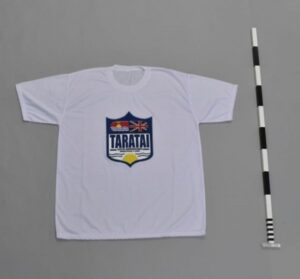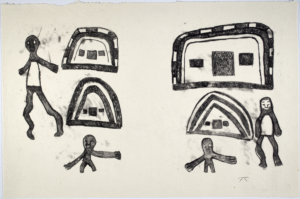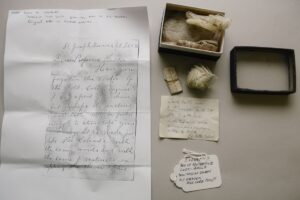At the end of November staff and students at the Museum of Archaeology and Anthropology got together for a pilot workshop on ‘Keywords’, to collaboratively and competitively search the online catalogue for things that aren’t necessarily easy to find. Two of the participants reflect on their experiences.
Blog posts on the MAA Digital Lab always start with an object in the MAA collections. So this one starts with a t-shirt from Kiribati. But how did we get here? How do we find untold stories in the museum database? How does museum documentation help or hinder us in making connections between things, people and histories?

At the Digital Lab and across the Museum, we’re keen to diversify the stories that are told around the global collections at MAA. Past UCM projects, like Bridging Binaries and Untold Histories, have emphasised how well-hidden marginalised or unconventional stories are within collections and databases.
At the end of November 2023 we invited staff, volunteers, and students from MAA to a pilot workshop where each of us would compete to start the process of answering these questions. Each of us would search the online catalogue for objects, images, and documents related to certain themes – so that we could build interesting groups of things and share techniques or terminology that could be used to find them, as well as to think about what we might be able to do more broadly to make these stories more visible.
Nine of us gathered in a room in the museum with our lunch and laptops, and worked through three rounds of competitive searching. In each round Aayushi Gupta – our Research Assistant – called out a keyword, and the contestants came up with search terms to find something relating to the theme in the MAA collection.
We started with ‘chastity’. Entering that term into a collection search brings back two records: an apron from the Oegworok People in Nigeria and a dance costume worn by unmarried Meithei women in Manipur, India. If you search for ‘unmarried’, you get 72 results, almost all things worn or used by unmarried women. The category of ‘unmarried men’ seems to be much less common. We found that many of the terms we tried, plus many of the objects, were associated with women – highlighting the gendered language we use in daily life and work, and the assumptions that underlie it. We also found that catalogue records don’t always give any explanation for the use of a term. Searching for ‘virgin’, for example, gives you (apart from many representations of the Virgin Mary, and many items from Virginia), a ‘virginity plaque’ from Egypt. But there is nothing to explain why it is so interpreted. If anyone out there knows more, then please let us know or write a blog post!
The next term we tried was very different: ‘filigree’. That calls up 196 records (149 of them with images). The search results are really diverse: mostly metal, of course, but also a bone comb, made by French prisoners of war in Norman Cross, near Peterborough – the first purpose-built prisoner of war camp, active during the Napoleonic Wars. This result shows an overlap between ‘filigree’ and ‘open-work’, and points to technical language being interpreted differently by different people at different times. The use of technical language in catalogue entries has been the subject of some debate within the museum: from a specialist point of view, it’s essential; from an accessibility point of view, it can be a barrier to finding them.
Finally, we turned to ‘alcohol’ inspired by the Digital Lab’s strand on Substances of Wellbeing and Intoxication. ‘Alcohol’ returns 30 results, among them a series of prints by Katunga Carimbwe from the Artist’s Press in Schmidtsdrift, South Africa. ‘Drinking’ gives 503 and ‘cup’ 2,254. There are 152 results for ‘beer’, 472 for ‘wine’ and 2 for ‘whisky’. One of the whisky references is a set of protective luck balls collected in Missouri by folklorist Mary Owen, the record for which includes a transcription of a letter from Owen to an Alfred Haddon advising him to ‘be sure to wet the ball once a week with whisky.’ There’s no evidence to suggest that Haddon or anyone else in the museum ever did so.

‘Gin’ gives a staggering 25,715 results, but this includes all records that includes words with ‘gin’ in it (we’ve already had ‘Virginia’, but let’s not forget occurrences of words like ‘originally’). ‘Shot’ returned 221 results, one of which is an actual shot glass for aguardiente from Mexico. ‘Cocktail’, surprisingly, returned 261 records because each record of the Gordon Barclay and Cecil Armitage collection from West Africa has a context note referring to the meeting of Barclay and Armitage at a cocktail party sometime around World War I.

At the very end of the session, one of the participants exclaimed ‘I tried liquor and got a t-shirt!’ The search had uncovered a context note in the record for a t-shirt (image shown earlier) collected at the 2017 Union Jack Festival in Kiribati, which explains that:
“In 1892 HMS Royalist, an Australian station third class cruiser, commanded by Irish Captain Edward Henry Meggs Davis, was sent to the Gilbert and Ellice Islands (now known as Kiribati and Tuvalu) to forestall possible annexation by Germany, and to control their recruitment of labour, the sale of guns and liquor, and to end growing turbulence in the islands. Davis declared the Gilbert Islands a British Protectorate.”
This all may seem like fun and games, and potentially frivolous, but there is an important point. Museum documentation conceals as much as it reveals. Language used is determined by the person who wrote it, the time they wrote it in, the discipline they worked in, and many other factors. Confusion, mistakes, and ambiguity are preserved in historic documentation, even when they have been corrected or resolved in a record. For museum staff or any user of a museum catalogue, navigating this complexity can be a challenge littered with rabbit holes, dead ends, and surprises.
Museum collections, and museums generally, are fundamentally collaborative and multi-authored. Objects are made and used by, collected or excavated by, given by, documented by, and conserved and interpreted by many, many people – acting alone or working together. Exhibitions or research are the result of constant back-and-forth exchanges, challenges, and compromises between a team of people and the objects and histories they are working with. Any effort to interrogate or critically think about – let alone transform – a museum’s database therefore demands that we try to get inside the heads of the people who have gone before us in the process of bringing these objects to public attention. For example:
- What categories did they put things in?
- What words did they use?
- What, not to put too fine a point on it, were they thinking?
It stands to reason, then, that searching catalogues should be a collaborative effort too.
At the end of our first session, we’ve come away with some new perspectives, new questions, and of course new keywords that we want to try out in the future. We’ll be holding more workshops like this in 2024, with staff, students, and willing participants inside and outside the university, in person and maybe also online. Look out for announcements through our usual channels or email us to find out more.
X (formerly known as Twitter) (1) Museum of Archaeology and Anthropology (@MAACambridge) / X (twitter.com)
Museum of Archaeology & Anthropology | Cambridge | Facebook
Museum of Archaeology and Anthropology (@maacambridge) • Instagram photos and videos







